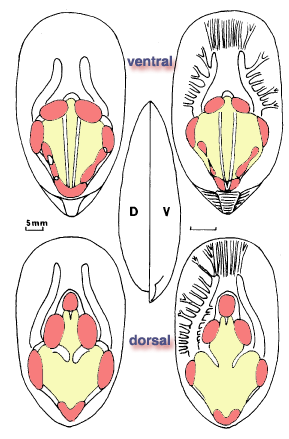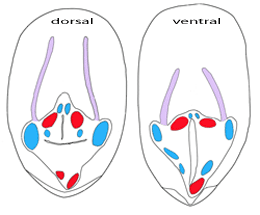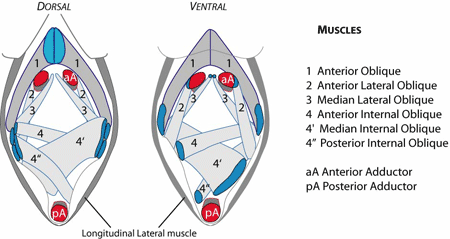 |
|
||||||
|
Genus Lingularia Biernat & Emig, 1993 |
| [Type-species = L. similis] - see figure below that belongs to the diagnoses of the species |
| Shell elongate oval in outline, lateral margins subparallel, anterior margin broadly rounded. Valves weakly to strongly convex. Ventral valve with triangular umbo formed by vestigial to small internal propareas, continuous with posterolateral margins and separated by deep pedicle groove; pair of narrow subparallel, V-shaped, grooves extends internally from the anterior adductor pair to posterior adductor where grooves join. Dorsal valve with posterior margin rounded, narrow median beak sometimes present, and a narrow internal central ridge extending over about 1 millimetre posterior to anterior oblique muscle scars.
Posterior adductor scar heart-like in outline. |
| Carboniferous-Cretaceous.
Occurrences: Carboniferous: Scotland, S Wales. Triassic: Bear Island, N Spain, N Siberia, West Pakistan, ? Japan, N USA, N Italy, New-Zealand. Triassic, Jurassic: Spitsbergen. Cretaceous: W Kazakhstan Egypt, SW Australia. Diagnosis from Biernat & Emig (1993) with complete description. NOTA: The diagnosis given in the Treatise (vol. 2, p. 36) does not correspond to this original one - see Emig (2003), as well as the geological range. There is no reference indicating a possible extension in the Tertiary as suggested in the Treatise
|
|
|
-------------- ? Lingula elliptica Phillips and L. parallela Phillips? L. straeleni Demanet ? L. lumsdeni Graham ? L. squamiformis Phillips ? L. aoraki Campbell, 1987 |
The references of this page are:
|
|
Lingula borealis Bittner, 1899; Newell & Kummel, 1942. Etymology: "similis" relates to its similar appearance to Lingula.
including the figures
Umbonal region rounded with median beak weak on dorsal valve, pointed on ventral valve; large propareas separated by deep pedicle groove, not continuous with internal valve face.
|
 |
|
Lingularia siberica Biernat & Emig, 1993 Lingula polaris Lundgren, 1883; Dagys, 1965.
Diagnosis - (Biernat & Emig, 1993) Numerous fine radial striae and commonly concentric microlines between thicker growth lines generally visible on the shell. Umbonal region rounded on dorsal valve, pointed on ventral valve; small propareas separated by a deep and wide striated pedicle groove, not continuous with internal valve face. Body muscles characterized by internal anterior oblique located near anterior oblique; internal posterior oblique not observed. Mantle canals almost straight, convergent.
|
 |
|
Lingularia smirnovae Biernat & Emig, 1993 ?Lingularia michailovae Smirnova & Ushatinskaya, 2001. Diagnosis - (Biernat & Emig, 1993)
Umbonal region rounded with weak median beak on dorsal valve, pointed on ventral valve; small propareas separated by deep and narrow pedicle groove, not continuous with internal valve face.
|
 |
|
Lingularia michailovae Smirnova & Ushatinskaya, 2001 Holotype: PIN 4796/12. Type locality: Sengilei, Ul'yanovk region. Type horizon: Lower Aptien, Lower Cretaceous. Diagnosis - (Smirnova & Ushatinskaya, 2001) see figure (modified after fig. 2 of Smirnova & Ushatinskaya, 2001) Shell small, up to 5 mm long, weakly uniformly biconvex, regularly oval in outline. Umbo rounded. Gently rounded lateral margins, grade into the anterior margin, posterior margin long, strongly curved, well defined from the other part of the shell. The greatest width is attained in posterior third.of the shell. According to Smirnova & Ushatinskaya (2001): "the new species is distinct from Lingularia smirnovae Biernat & Emig, 1993 in its regularly oval shell outline, smaller size, rounded lateral commissures, location of greatest width, and narrower anterior margin. It is distinct from L similis Biernat & Emig, 1993 in its smaller size, rounded lateral margins, location of greatest width and thickness of the shell, and narrow pseudointerarea." NOTA: all the above cited characters to distinguish species have been demontsrated as no-taxonomic characters by Biernat & Emig (1993). On the other hand, the muscle arrangement of this species and those of Lingularia smirnovae(see figures) appear rather similar.
|
 |
|
Lingularia? notialis Holmer et Bengston, 2009 Lingularia? bagualensis (Wilckens, 1907). Holotype: MN 8283-I . Type locality: Oiteiro, Sergipe Basin, Brazil. Type horizon: upper Turonian of the Cotinguiba Formation. Diagnosis and figures (from Holmer & Bengston, 2009) Ventral pseudointerarea wide with small propareas separated by a wide and deep pedicle groove, level with valve floor; ventral umbonal muscle scars not bisected by groove of pedicle nerve. Dorsal pseudointerarea poorly defined, forming short, slightly thickened, crescent-shaped rim; dorsal umbonal muscle scar possibly double. Mantle canals of both valves narrow. Both valves with large lophophoral cavity occupying more than half of total valve width. Shell structure baculate. |
 |
|
Lingularia sp. Hori et Campbell, 2004 'Lingula sp.' Bragin,1991. Holotype: . Type locality: Shikoku, Japan . Type horizon: Anisian (early Middle Triassic). |
|
|
Lingularia ex gr. tenuissima (Bronn, 1837) Proposed by Sykora et al. (2011) - no taxonomic characters, no diagnosis - just based on a discussion. |
|
|
Lingularia salymica Smirvova, 2015, in Smirnova et al., 2015 Occurrence: West Siberia, Shirotnoe Priob’e; Upper Jurassic, transitional layers between the Abalak and Bazhenov formations. Holotype: PIN 4898/4140, ventral valve interior. Type locality: West Siberia, Shirotnoe Priob’e. Type horizon: Upper Jurassic, transitional beds between the Abalak and Bazhenov formations. Diagnosis : no diagnosis available The comparison with other species of Lingularia is based characters well known to have no taxonomic value: |
|
|
Nota : no diagnosis available - is in some studies names as Lingularia mytiloides (Sowerby, 1912) without any reference to the description of this species under its genus name ! See Mottequin et al. (2019) and Denov (2024). Nervertheless, this species may be a synonym of Eolingularia siberica. |
|


